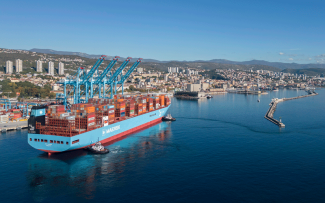Rijeka Gateway Terminal – a new competitor in the race for Central European markets

On 29 October 2025, the Rijeka Gateway container terminal was officially opened in the presence of Croatian Prime Minister, Andrej Plenković, Danish Foreign Minister, Lars Løkke Rasmussen, and Keith Svendsen, the CEO of APM Terminals, which is owned by the global shipping company Maersk. This marks the Danish-based company’s first investment in Central Europe.
Maersk has joined other major shipping lines in strengthening their presence in the Adriatic Sea, following the French-based CMA CGM, which has been expanding its cooperation with Koper (Slovenia), and the Swiss–Italian MSC, which has invested in Trieste (Italy). Croatian officials have announced plans to build a railway line to the Hungarian border – a long-promised project that would strengthen Rijeka’s position in both the Western Balkans and Central Europe. Without this connection, the port will struggle to compete effectively with both Koper and Trieste.
Dominance in the Adriatic
The Croatian government aims to transform Rijeka into a hub for handling cargo flows between Europe and Asia as well as serving Central European markets. It also seeks to position the port as a competitor to Koper and Trieste for a leading position in container transshipment in the Adriatic. Once the largest port in Yugoslavia, Rijeka continues to evoke nostalgia for its past prominence. However, the wars of the 1990s undermined its position, while Koper expanded rapidly. Over the past three decades, the Croatian port has suffered from chronic underinvestment. Successive governments have also struggled to articulate a coherent strategy for its development. Koper has capitalised on Rijeka’s long period of decline, gradually expanding its hinterland into key markets such as Hungary and Serbia.
Rijeka has traditionally focused on handling bulk cargo, primarily coal, grain, and iron ore. By contrast, Koper has prioritised containers – the most promising and profitable cargo segment – and vehicles. Overall, the Slovenian port handles significantly more bulk cargo than its Croatian rival: in 2024, it processed 23 million tonnes, compared with approximately 11.8 million tonnes in Rijeka.
In this sector, Trieste is the undisputed leader in the Adriatic, with throughput of 59.5 million tonnes annually. This dominance stems primarily from its core specialisation in oil transhipment: it handles the largest volumes of oil in the entire Mediterranean basin. Trieste is the starting point of one of Europe’s most important oil pipelines – the Transalpine Pipeline (TAL), which supplies 90% of Austria’s crude oil needs and 100% of those of southern Germany and the Czech Republic. In the latter case, the share of imports via the TAL has risen from 50% in recent years, reflecting the successful diversification of Czech oil imports. In 2024, the TAL’s capacity was expanded by an additional 4 million tonnes per year following the completion of a modernisation project known as TAL-PLUS, commissioned by the pipeline’s shareholders, among them the Czech government through the state-owned company Mero. As a result, the pipeline is expected to deliver 7 to 8 million tonnes of oil to the Czech Republic annually.
In recent years, Trieste has also begun to expand its container handling capacity. In this segment, it is now the second-largest operator in the Adriatic, just behind Koper, with throughput of around 730,000 TEU in 2024. Since 2023, Koper has handled more than 1 million TEU annually – twice as much as Rijeka with 501,000 TEU. Until now, container traffic at the Croatian port has been driven by a single terminal – the Adriatic Gate Container Terminal (AGCT), which opened in 1977 and is also known by its Croatian name Jadranska Vrata (Adriatic Gate). However, it has a limited capacity of 600,000 TEU per year that is yet to be fully utilised; in 2024, it handled just over 400,000 TEU. Years of delays in modernising the infrastructure have left Croatia’s largest port far behind its main competitors, with little realistic prospect of closing the gap. Since 2011, the Philippine-based ICTSI, one of the world’s largest port operators, has held a 51% stake in AGCT, which has served vessels operated by major global shipping lines such as MSC, CMA CGM, China’s Cosco and OOCL, Taiwan’s Evergreen, Germany’s Hapag-Lloyd, and Maersk. The latter two are now expected to transfer their operations to the Rijeka Gateway terminal.
A new player backed by Maersk
Rijeka Gateway is set to reshape the port landscape of the Adriatic Sea. It is the most modern and technologically advanced container terminal in the region, equipped with four remotely operated STS (ship-to-shore) cranes manufactured by the Chinese company ZPMC, used for transferring cargo between vessel and shore, as well as 15 rubber-tyred gantry cranes (RTGs) and two rail-mounted gantry cranes (RMGs) supplied by Germany’s Liebherr. It is connected to a 5G network; approximately 95% of its operations are powered by electricity. As the largest private infrastructure investment in Croatia to date, the terminal has the potential to stimulate the country’s economic growth and to generate substantial revenue for the state budget from customs duties, VAT, and excise taxes.
Maersk, the world’s second-largest shipping line, has recognised Rijeka’s potential. It leads the consortium consisting of APM Terminals, its subsidiary holding 51% of the shares in the new terminal, and the Croatian logistics company Enna Logic, a minority shareholder with 49%. Enna Logic is part of the ENNA Group, which also includes companies operating in the energy and natural gas sector (notably PPD, one of Croatia’s largest firms), transport (Enna Transport) and retail (Fortenova, the owner of the supermarket chain Konzum and the press distributor Tisak), as well as the port in the city of Ploče, which primarily serves Bosnia and Herzegovina. ENNA Group is owned by Pavao Vujnovac, one of Croatia’s leading businessmen. Maersk would not be present in Rijeka had Chinese bidders not been excluded from the tender process. A consortium consisting of Ningbo Zhoushan Port Company Limited, Tianjin Port Overseas Holding Limited and China Road and Bridge Corporation was the initial winner, but the Croatian government cancelled the procedure following political pressure from the United States and the European Union. APM Terminals and Enna Logic emerged victorious in the new tender. The contract for the terminal’s construction was signed in November 2021; the two companies were granted a 50-year concession to operate the facility.
The first phase of the project, valued at €210 million, has now been completed; the second phase is expected to cost €180 million. The project’s total value, including Croatian government investments in access infrastructure, both rail and road, is projected to reach €600 million. Once fully operational, Rijeka Gateway will be capable of handling 1 million TEU annually and accommodating the world’s largest container vessels with a capacity of up to 24,000 TEU. Its throughput will match the current capacity of Koper; however, the Slovenian port has been actively implementing a project to expand its container terminal, scheduled for completion by 2027, which will enable it to handle up to 1.8 million TEU annually.
Major shipping lines in the Adriatic
In recent years, Adriatic ports have become a focal point of competition among the world’s largest shipping lines. MSC, the global leader in container shipping, holds equity in two terminals in Trieste. In 2022, it increased its stake in the Trieste Marine Terminal from 50% to 80%. The following year, it acquired a 49.9% stake in the German logistics operator HHLA, thereby gaining influence over the operations of a second terminal in the city, Piattaforma Logistica di Trieste.
Meanwhile, France’s CMA CGM has focused its efforts on Koper. Although it has not invested directly in the local container terminal, it has cooperated closely with the port, treating it as its principal hub on the Adriatic Sea. On 20 October, in the presence of French President Emmanuel Macron and Slovenian Prime Minister Robert Golob, the shipping line and the Port of Koper signed an agreement to establish a joint venture providing logistics services for the automotive sector. The Slovenian port has also concentrated on vehicle transhipments, operating one of Europe’s largest automotive terminals; the partnership with CMA CGM is expected to further strengthen its position in this cargo segment.
Maersk’s equity investment in Rijeka will enable it to compete more effectively with Koper and Trieste. As a result of this investment, the Croatian terminal has already been integrated into the service networks of the Danish carrier and the German company Hapag-Lloyd, which cooperates with Maersk through the Gemini Cooperation. Shipping lines generally favour ports in which they hold stakes, as this enables them to optimise costs and increase profitability. Rijeka Gateway stands to benefit from this development in two ways: it has secured stable cargo volumes, and it will also weaken the growth prospects and operational activity of the competing AGCT terminal, which has long operated regular rail services on more than 10 routes, connecting destinations in Austria, Bosnia and Herzegovina, the Czech Republic, Serbia, and Hungary. The Danish giant is seeking to expand into these very markets. It aims to use Rijeka Gateway as a hub serving the Western Balkans, Central European states, and even southern Germany. It has set a target for 60% of cargo handled at the port to be transported by rail, although this remains an ambitious goal for the time being.
The weakest link
Rijeka’s major weakness is Croatia’s outdated rail infrastructure. Koper holds an advantage in this area owing to far greater progress in rail development in Slovenia. Since 2021, a new line has been under construction on the Divača-Koper section, scheduled for completion at the end of March 2026. In addition, in October 2024, the Slovenian parliament approved the construction of a second line to further improve the port’s rail connectivity. Work on this project is set to begin in 2026, with completion expected by 2030. As a result, Koper will become an even more formidable competitor.
The main rail line connecting the Port of Rijeka to Zagreb and onwards to the Hungarian border was built in 1873. It is a single-track line, which severely limits its capacity, and it has not been adapted to the requirements of modern freight transport. At present, only around 25% of cargo transshipped at the port is transported by rail – one of the lowest shares in the EU. The Croatian government has long been considering the construction of the so-called lowland railway between Rijeka and the capital. Until now, a lack of funding has been the primary obstacle. However, the government now appears determined to press ahead with this initiative, which is strongly supported by Maersk, describing it as the country’s ‘most important national project’ alongside Rijeka Gateway.
In recent months, planning work on the railway line has accelerated. In September, an environmental permit was approved for the key Skradnik-Krašica-Tijani section, which runs through mountainous terrain, posing significant engineering challenges. For this reason, more than a dozen tunnels are planned along the route, which could lead to delays and increased project costs. Constructing the section within the city of Rijeka poses another major challenge, as it will require the expropriation of residents living along the planned route. The engineering design for the Rijeka-Zagreb railway is scheduled for completion in 2026, with construction due to be completed by 2036.
The project also faces additional challenges, such as the sluggishness of the Croatian administration and a shortage of locally based engineers with substantial experience in railway design. As a result, foreign companies are likely to secure forthcoming tenders. There have been growing calls in Croatia for a special railway law to streamline the implementation process. Without the new railway line, the Port of Rijeka will be unable to compete effectively for Central European markets.
Thanks to the involvement of Maersk, which has also been actively expanding its transport and freight-forwarding services in the region, Rijeka Gateway may gain a competitive edge in handling cargo flows to Hungary, Austria, the Czech Republic, and even Slovakia in the coming years. With regards to the latter two countries in particular, it could emerge as a competitor to Polish ports. In the long term, however, Rijeka’s ability to compete effectively with Koper will depend on progress in implementing the key railway project described above.





